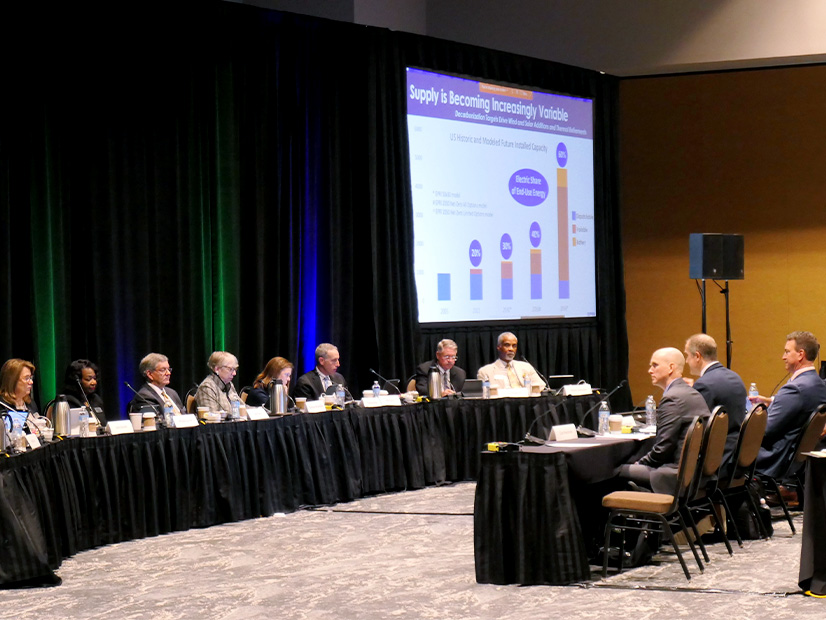MADISON, Wis. — MISO membership and executives last week discussed how to hasten the construction of more than 40 GW of generation projects that have permission to connect to the grid but haven’t been built.
At MISO Board Week June 13-15, MISO leadership repeatedly mentioned that the system is sitting on 42 GW of unbuilt resources that have cleared the interconnection queue and would shore up deteriorating reserves.
During a resource adequacy roundtable at the June 14 Advisory Committee meeting, MISO Director Todd Raba asked how MISO might spur construction on those projects with signed agreements.
Sustainable FERC Project’s Natalie McIntire said supply chain issues are part of the equation, but she said many projects are waiting on future regional transmission projects.
“These generators don’t have a highway to market, so they’re not being built. So, we have a variety of issues that are coming to play here,” she said.
Sierra Club attorney Greg Wannier agreed new transmission is key to easing resource adequacy concerns.
Travis Stewart, representing the Coalition of Midwest Power Producers, said many of those paused generation projects were proposed three to five years ago in a pre-COVID world and have since been subject to macroeconomic challenges. He said the projects are emerging from “COVID limbo,” with developers now figuring out how they can be adjusted to be profitable.
Wisconsin Public Service Commissioner Tyler Huebner said the faster MISO can get generation projects through the queue and connected, the sooner the footprint’s resource adequacy concerns can be downgraded.
During the June 15 board meeting, Senior Vice President of Markets Todd Ramey said MISO is surveying the developers behind the interconnection projects. In some cases, the projects have languished with generator interconnection agreements that are now two years old.
“Bringing new resources online is an important part of the reliability imperative,” Ramey said. He added that MISO is ready to support the developers to lessen “bottlenecks” to building.
In a public comment session, John Norris, former chair of the Iowa Utilities Board and former FERC commissioner, chastised MISO for not getting a jump on major planning sooner to bring new resources online.
He said MISO is wasting its time proposing new restrictions on which generation projects can enter its interconnection queue when new transmission routes would allow generation projects to proceed.
Norris said when even his teenage son is aware that a “gazillion” gigawatts of renewable energy are stalled in interconnection queues because the grid is insufficient, it’s a good indication that the public is increasingly aware that new transmission is foundational to the clean energy transition.
Norris said it’s appalling that there’s now going to be at least a “quarter century” of lag time between Entergy and other southern entities forming MISO South and MISO overseeing an expanded transfer built between MISO Midwest and South. Norris was relying on an average decadelong planning and construction phase for major transmission for the 25-year estimate. MISO’s center-of-the-country position means it has a distinct duty to ensure that transmission is being built sooner, he argued.
In the long run, MISO is still banking on a flock of new renewable sources — and a host of new requirements to govern them.

Executive Director of Resource Planning Scott Wright said the 466 GW of nameplate capacity MISO envisions having in 20 years is going to be “a different animal” and introduce new market complexities. (See related story, MISO Modeling Line Options for 2nd LRTP Portfolio.)
“We’re going to have 400 GW, four times the load, because of the attributes we desire,” he told MISO’s Advisory Committee.
MISO said in the future it will likely measure hourly energy adequacy, use AI to manage uncertainty and target certain amounts of reliability attributes from generation.
“We feel we’re sitting in an untenable position not making these reforms, maybe sitting in an unsafe position not making these reforms,” Wright said.
WEC Energy Group’s Chris Plante said, “Maybe MISO should consider clearing an amount of resources with certain [reliability] attributes.” MISO has said six generating attributes are necessary to its system operations: availability, delivering long-duration energy at a high output, rapid startup times, providing voltage stability, ramp-up capability and fuel assurance. (See MISO to Evaluate System Attributes Through Year’s End.)
Plante said capacity auction prices bouncing from “next to nothing” to the cost of new entry is evidence that other states and load-serving entities might not be carefully planning how to furnish those attributes.
“We plan on bringing our fair share to the table. Others should do the same,” he said.
MISO Director Mark Johnson asked if some entities have possibly “lost sight of their obligation to serve” because they have belonged to the larger MISO resource pool for so long. Members pushed back and insisted their individual load obligations are top of mind amid the fleet transition.
McIntire said MISO’s Planning Resource Auction “isn’t necessarily giving us a signal about the future” because it measures capacity for only one year. She asked that MISO put together a “new, more formalized” resource adequacy forecast that predicts accredited capacity on five-, 10- and 15-year horizons.
MISO CEO John Bear said MISO has much to do to address emerging reliability risks. He said the ongoing discussion on how to encourage generation that can provide certain system attributes is crucial.
“How do we find these controllable, long-duration resources that can cover our risk during a wind or sun drought? We’ve got to work on that. We’ve got to get to that,” Bear said at MISO’s board meeting.


